Wednesday, November 23, 2005
Eating Ottawa
Just a word to tell you that I started working on a new blog dedicated to the relatively poor restaurant scene in Ottawa, the capital of Canada. Although it is definitely not the best city to eat out (try Montreal, Vancouver or Toronto instead) it is the city I live in and I am sure I'll be able to find a couple of jewels.
http://eatingottawa.blogspot.com/
Juste un petit mot pour vous dire que j'ai commencé à travailler sur un nouveau blog dédié au monde de la restauration d'Ottawa, la capitale canadienne. Ottawa n'est certainement la ville la plus intéressante pour sortir ou resto (pour cela Montréal, Vancouver et Toronto sont bien plus intéressante) mais c'est la ville où j'habite et j'ai confiance de pouvoir y trouver quelques perles rares.
http://eatingottawa.blogspot.com/
Juste un petit mot pour vous dire que j'ai commencé à travailler sur un nouveau blog dédié au monde de la restauration d'Ottawa, la capitale canadienne. Ottawa n'est certainement la ville la plus intéressante pour sortir ou resto (pour cela Montréal, Vancouver et Toronto sont bien plus intéressante) mais c'est la ville où j'habite et j'ai confiance de pouvoir y trouver quelques perles rares.
Quel est ce légume? - What is that vegetable?
(This post is written in French but if you have any information or question about this vegetable, I would be glad to hear about it in either French or English)

 Voici un de mes légumes chinois préféré. Je ne sais pas comment ça pousse ni comment ça s'appelle. À la maison on l'appelle 'magic plant' (plante magique) car il ressemble un peu à la quenouille qui est vraiment une plante magique car on peut manger à peu près n'importe quelle partie de cette plante: rhizome, jeune tige et jeune épi. Enfin, je sais que ce n'est pas très clair tout ça; disons simplement qu'en discutant avec ma copine nous en étions venu à la conclusion que les deux plantes se ressemblaient mais nous ne connaissions ni l'un ni l'autre le
Voici un de mes légumes chinois préféré. Je ne sais pas comment ça pousse ni comment ça s'appelle. À la maison on l'appelle 'magic plant' (plante magique) car il ressemble un peu à la quenouille qui est vraiment une plante magique car on peut manger à peu près n'importe quelle partie de cette plante: rhizome, jeune tige et jeune épi. Enfin, je sais que ce n'est pas très clair tout ça; disons simplement qu'en discutant avec ma copine nous en étions venu à la conclusion que les deux plantes se ressemblaient mais nous ne connaissions ni l'un ni l'autre le 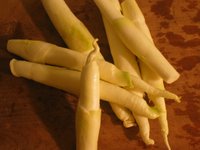 nom de chacune des plantes en anglais et les avons surnommées toutes les deux 'magic plant'. À ce que j'en sache toutefois, il ne s'agit pas de quenouille mais d'une autre plante... enfin, c'est difficile de vérifier car je ne connais pas du tout le nom de cette plante.
nom de chacune des plantes en anglais et les avons surnommées toutes les deux 'magic plant'. À ce que j'en sache toutefois, il ne s'agit pas de quenouille mais d'une autre plante... enfin, c'est difficile de vérifier car je ne connais pas du tout le nom de cette plante.
Lors de mon séjour en Chine en 2004, ma belle soeur a réussi à savoir que j'adorais ce légume et m'en a préparé tous les jours pendant une semaine. Et vous savez quoi? je ne m'en suis même pas fatigué! Il faut dire qu'ici on n'en trouve pas souvent sur les étals des épiceries chinoises et que lorsqu'on trouve, ma copine et moi s'en régalons! Je crois qu'il s'agit d'un produit très saisonier.
quoi? je ne m'en suis même pas fatigué! Il faut dire qu'ici on n'en trouve pas souvent sur les étals des épiceries chinoises et que lorsqu'on trouve, ma copine et moi s'en régalons! Je crois qu'il s'agit d'un produit très saisonier.
Pour déguster ce légume, il faut enlever les feuilles vertes coriaces et trancher la partie blanche dans le sens contraire des fibres (comme pour le poireau ou le céleri). Ma copine, ainsi que ma belle soeur, les font généralement sauter à feu très vif au wok avec des piments forts, de l'ail et parfois du gingembre et un trait de sauce soya. C'est tout simple et délicieux!

 Voici un de mes légumes chinois préféré. Je ne sais pas comment ça pousse ni comment ça s'appelle. À la maison on l'appelle 'magic plant' (plante magique) car il ressemble un peu à la quenouille qui est vraiment une plante magique car on peut manger à peu près n'importe quelle partie de cette plante: rhizome, jeune tige et jeune épi. Enfin, je sais que ce n'est pas très clair tout ça; disons simplement qu'en discutant avec ma copine nous en étions venu à la conclusion que les deux plantes se ressemblaient mais nous ne connaissions ni l'un ni l'autre le
Voici un de mes légumes chinois préféré. Je ne sais pas comment ça pousse ni comment ça s'appelle. À la maison on l'appelle 'magic plant' (plante magique) car il ressemble un peu à la quenouille qui est vraiment une plante magique car on peut manger à peu près n'importe quelle partie de cette plante: rhizome, jeune tige et jeune épi. Enfin, je sais que ce n'est pas très clair tout ça; disons simplement qu'en discutant avec ma copine nous en étions venu à la conclusion que les deux plantes se ressemblaient mais nous ne connaissions ni l'un ni l'autre le  nom de chacune des plantes en anglais et les avons surnommées toutes les deux 'magic plant'. À ce que j'en sache toutefois, il ne s'agit pas de quenouille mais d'une autre plante... enfin, c'est difficile de vérifier car je ne connais pas du tout le nom de cette plante.
nom de chacune des plantes en anglais et les avons surnommées toutes les deux 'magic plant'. À ce que j'en sache toutefois, il ne s'agit pas de quenouille mais d'une autre plante... enfin, c'est difficile de vérifier car je ne connais pas du tout le nom de cette plante.Lors de mon séjour en Chine en 2004, ma belle soeur a réussi à savoir que j'adorais ce légume et m'en a préparé tous les jours pendant une semaine. Et vous savez
 quoi? je ne m'en suis même pas fatigué! Il faut dire qu'ici on n'en trouve pas souvent sur les étals des épiceries chinoises et que lorsqu'on trouve, ma copine et moi s'en régalons! Je crois qu'il s'agit d'un produit très saisonier.
quoi? je ne m'en suis même pas fatigué! Il faut dire qu'ici on n'en trouve pas souvent sur les étals des épiceries chinoises et que lorsqu'on trouve, ma copine et moi s'en régalons! Je crois qu'il s'agit d'un produit très saisonier.Pour déguster ce légume, il faut enlever les feuilles vertes coriaces et trancher la partie blanche dans le sens contraire des fibres (comme pour le poireau ou le céleri). Ma copine, ainsi que ma belle soeur, les font généralement sauter à feu très vif au wok avec des piments forts, de l'ail et parfois du gingembre et un trait de sauce soya. C'est tout simple et délicieux!
Tuesday, November 22, 2005
Watercress and gravlax pasta
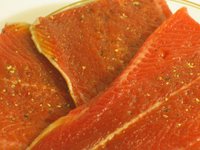 This is what I've done with some of the gravlax I've made: an easy pasta dish. We are at the point in the week where we have to clean the fridge from the little leftovers we have before doing some grocery shopping again. We had:
This is what I've done with some of the gravlax I've made: an easy pasta dish. We are at the point in the week where we have to clean the fridge from the little leftovers we have before doing some grocery shopping again. We had:- Celery
- Gravlax
- Water cress
- Manchego cheese
 - and a few other ingredients in our pantry: garlic, olive oil, pasta...
- and a few other ingredients in our pantry: garlic, olive oil, pasta...And since we didn't have much time (badminton night!) we decided to make some pasta with these ingredients. The result was alright... nothing great to be honest but more then edible. This kind of pasta dishes are becoming a weekly occurrence, we might have to rethink our kitchen cleaning practices.
Monday, November 21, 2005
Old recipe books - Vieux livres de cuisine
I just found these two web sites containing a wealth of very old cookbooks.
Want to know what your ancestors were cooking? How they were cooking it? Have a look at these websites:
http://digital.lib.msu.edu/projects/cookbooks/index.html
http://www.collectionscanada.ca/cuisine/index-e.html
If you know of any other cookbook database, please let me know!
=================================
Je viens de trouver deux librairies virtuelles contenant chacune plusieurs livres de cuisine.
Vous voulez savoir ce que vos ancetres mangeaient? Comment ils le cuisinaient? Allez voir ces sites web:
http://digital.lib.msu.edu/projects/cookbooks/index.html
http://www.collectionscanada.ca/cuisine/index-e.html
Si vous connaissez d'autres librairies virtuelles de ce genre, laissez-moi le savoir!
Want to know what your ancestors were cooking? How they were cooking it? Have a look at these websites:
http://digital.lib.msu.edu/projects/cookbooks/index.html
http://www.collectionscanada.ca/cuisine/index-e.html
If you know of any other cookbook database, please let me know!
=================================
Je viens de trouver deux librairies virtuelles contenant chacune plusieurs livres de cuisine.
Vous voulez savoir ce que vos ancetres mangeaient? Comment ils le cuisinaient? Allez voir ces sites web:
http://digital.lib.msu.edu/projects/cookbooks/index.html
http://www.collectionscanada.ca/cuisine/index-e.html
Si vous connaissez d'autres librairies virtuelles de ce genre, laissez-moi le savoir!
Gravlax (take 2)
I made an extremely salty gravlax a few weeks ago and was not too pleased with it. But I am not the kind of cook who gets discouraged easily as I actually enjoy a good challenge (at least in the kitchen). This time however, I decided to follow a recipe instead of relying solely on my limited knowledge and instinct. Since a gravlax recipe was presented a week or two ago at one of Canada’s best cooking show (A la di Stasio) I decided to experiment with their formula.
The ingredients are as follow:
7 x sugar
5 x coarse salt
3 x ground white pepper
4 x smoked tea leaves
I liked the idea of having a strong pepper flavour so I used a mixture of green, white, black and pink peppercorns instead of white pepper but decided to forego the tea leaves which I believe would only alter the flavour, not the final texture or the curing process itself.
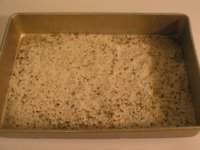
I then placed a part of this mixture in a pan;
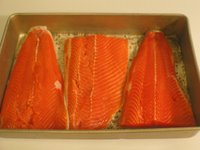
Placed three small salmon filet on top;

Covered them with the rest of the mixture;
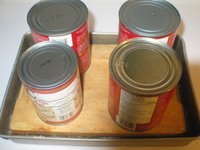 And placed a cutting board and four large cans on top to create a press.
And placed a cutting board and four large cans on top to create a press.
This time, I placed the fish in its homemade press in the refrigerator for 5 days, turning the filets a couple of time during the process. There was a problem however: I didn’t read the recipe carefully… it clearly stated to use only ¼ cup of the dry mixture per pound of salmon filet and I probably used more than a cup for each of my small filet.

The filets turned out to be very dry and were a bit too sweet for my taste. The saltiness is surprisingly at a more appropriate level than the last time but it is still a bit too high. The fish is also very peppery; it is almost too strong to eat it as is but I am guessing that it would be much nicer when paired with other ingredients (pasta, cheese, bread…).
Next time, I will:
- Use a 50% - 50% ratio for salt and sugar.
- Reduce the amount of sugar and salt used to at least ½ cup per pound of fish filet.
- Use less weight on my press to avoid loosing too much water and thickness.
The ingredients are as follow:
7 x sugar
5 x coarse salt
3 x ground white pepper
4 x smoked tea leaves
I liked the idea of having a strong pepper flavour so I used a mixture of green, white, black and pink peppercorns instead of white pepper but decided to forego the tea leaves which I believe would only alter the flavour, not the final texture or the curing process itself.

I then placed a part of this mixture in a pan;

Placed three small salmon filet on top;

Covered them with the rest of the mixture;
 And placed a cutting board and four large cans on top to create a press.
And placed a cutting board and four large cans on top to create a press.This time, I placed the fish in its homemade press in the refrigerator for 5 days, turning the filets a couple of time during the process. There was a problem however: I didn’t read the recipe carefully… it clearly stated to use only ¼ cup of the dry mixture per pound of salmon filet and I probably used more than a cup for each of my small filet.

The filets turned out to be very dry and were a bit too sweet for my taste. The saltiness is surprisingly at a more appropriate level than the last time but it is still a bit too high. The fish is also very peppery; it is almost too strong to eat it as is but I am guessing that it would be much nicer when paired with other ingredients (pasta, cheese, bread…).
Next time, I will:
- Use a 50% - 50% ratio for salt and sugar.
- Reduce the amount of sugar and salt used to at least ½ cup per pound of fish filet.
- Use less weight on my press to avoid loosing too much water and thickness.
Sunday, November 20, 2005
Good stew made with flavourless meat
 I've been recycling ingredients again. This time I made a stew using the veal cubes that served as a flavour booster to my veal stock. I knew I had to add strongly flavoured ingredients to this stew in order to get something reasonably good out of these now insipid meat cubes so I added some Dijon mustard, leek, thyme, bay leaves, and tons of mushrooms. Many of these mushrooms came from my collection of dried mushrooms that I harvested this fall. They included some cepes (porcini), a few oyster mushrooms and some aborted entolomas. The rest was the usual white button mushrooms. The added liquids were some beef broth and cream. The stew was ok, better than what you get at most cafeterias, but it lacked complexity and especially a nice meat flavour... but at least the mushrooms did their job!
I've been recycling ingredients again. This time I made a stew using the veal cubes that served as a flavour booster to my veal stock. I knew I had to add strongly flavoured ingredients to this stew in order to get something reasonably good out of these now insipid meat cubes so I added some Dijon mustard, leek, thyme, bay leaves, and tons of mushrooms. Many of these mushrooms came from my collection of dried mushrooms that I harvested this fall. They included some cepes (porcini), a few oyster mushrooms and some aborted entolomas. The rest was the usual white button mushrooms. The added liquids were some beef broth and cream. The stew was ok, better than what you get at most cafeterias, but it lacked complexity and especially a nice meat flavour... but at least the mushrooms did their job!
Subscribe to:
Posts (Atom)

